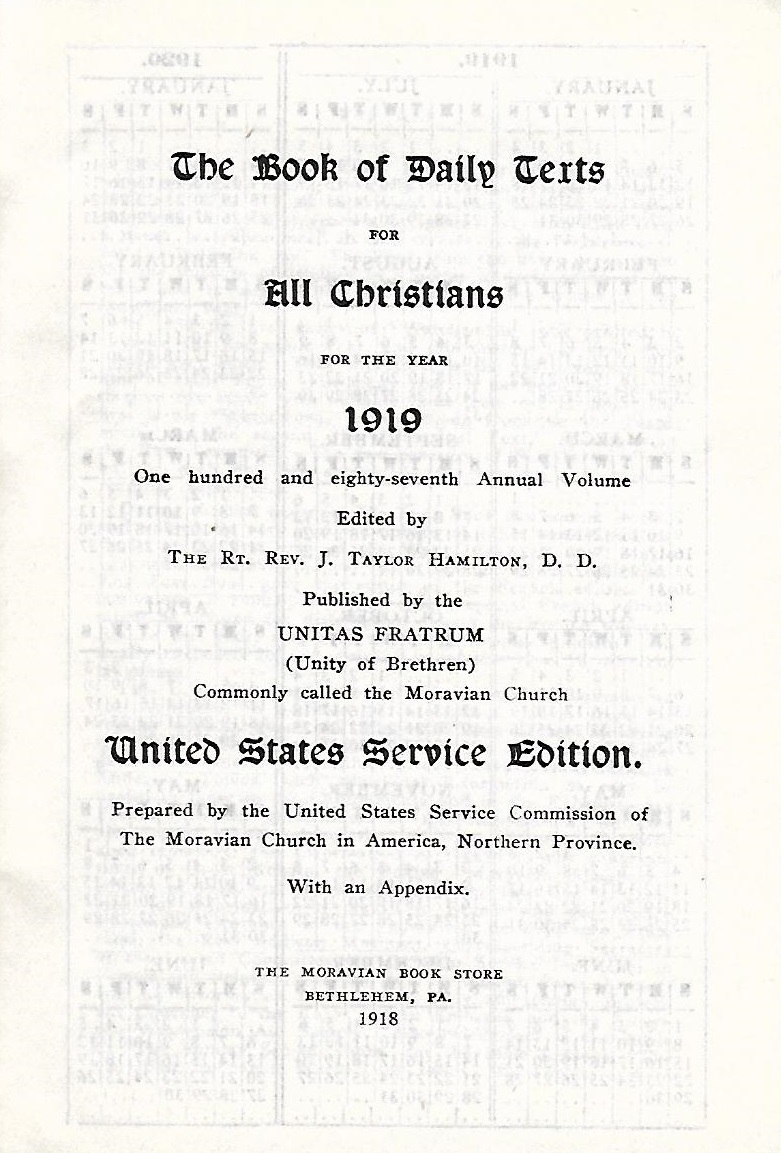Daily Text
**This collection is currently undergoing digitization and new volumes will be added as they are completed.**
Excerpted from a post on moravian.org, linked to below.
In 1722 refugees from Bohemia and Moravia began arriving at the estate of Count Nicholas Ludwig von Zinzendorf (1700-1760), where he gave them a welcome and land on which to establish the settlement of Herrnhut (“Watch of the Lord”). Each day the settlers came together for morning and evening devotions, consciously placing their lives in the context of God’s Word. On May 3, 1728, during the evening service, Count Zinzendorf gave the congregation a “watchword” for the next day. It was to be a “Losung” (watchword) to accompany them through the whole day. Thereafter one or more persons of the congregation went daily to each of the 32 houses in Herrnhut to bring them the watchword for the day, and engage the families in pastoral conversations about the text. From this oral tradition, the Daily Texts soon became fixed in printed form. Zinzendorf compiled 365 watchwords for the year and the first edition of the Losungen was published for 1731.
For the Daily Texts, as for the whole Moravian Church, Count Zinzendorf’s death (May 9, 1760), was a turning point. His co-workers sensed the uniqueness of Zinzendorf’s watchwords, textbooks, and lessons and had them published at Barby-on-the-Elbe in a four-volume collection 1762. From then on the watchwords and doctrinal texts are distinguished by the way they are selected each year. The watchwords are chosen from various verse collections and, since 1788, they have been drawn by lot from a collection of around 2,000 suitable Old Testament texts. The doctrinal texts are not chosen by lot but are selected. The difference between the watchwords and doctrinal texts was explained in 1801 as follows: “The watchword is either a promise, an encouragement, an admonition or word of comfort; the doctrinal text contains a point of revealed doctrine.”
By 1812 it was established that all watchwords would be drawn by lot from a selection of Old Testament texts, and the doctrinal texts would be selected from the New Testament. By the end of the nineteenth century, the custom was established to relate the two texts in theme or thought. The biblical texts for each day are chosen in Herrnhut, Germany, and then sent around the world to those who prepare the different language editions. Since 1959 the edition published in the United States has included a prayer for each day. For this North American edition, the hymns are chosen or written, and the prayers are written by Moravian clergy and laypersons from the United States and Canada. Each month is prepared by a different individual or couple, of a variety of ages, so that the prayers reflect the great diversity of devotion in the Moravian Church.
Your search has also found results in related AM products.
Show me the resultsCopy the below link to share this set of search criteria with others. Using the link will allow others to see a list of search results on this site with the same parameters as those you've used.

